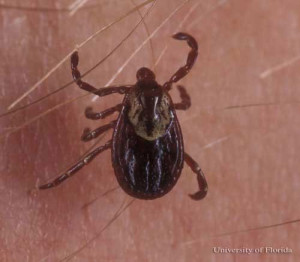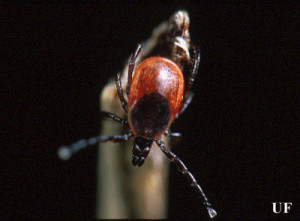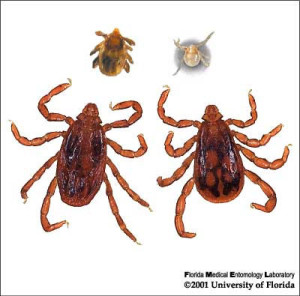 American Dog Tick
American Dog Tick
Dermacentor variabilis (Say), also known as the American dog tick or wood tick, is found predominantly in the United States, east of the Rocky Mountains, and as its name suggests, is most commonly found on dogs as an adult. The tick also occurs in certain areas of Canada, Mexico and the Pacific Northwest of the U.S. (Mcnemee et al. 2003). Dermacentor variabilis is a 3-host tick, targeting smaller mammals as a larva and nymph and larger mammals as an adult. Although it is normally found on dogs, this tick will readily attack larger animals, such as cattle, horses, and even humans. The 8-legged adult is a vector of the pathogens causing Rocky Mountain spotted fever (RMSF) and tularemia, and can cause canine tick paralysis. While the American dog tick can be managed without pesticides, when necessary a recommended acaricide is an effective way of eliminating an existing tick infestation near residences.
 Deer Tick
Deer Tick
Lyme disease was first recognized in 1975 as a distinct clinical disorder (Steere et al. 1977) and is currently the most frequently reported vector-borne disease in the United States (CDC 1995). Transmission of the spirochete B. burgdorferi, the causative agent of Lyme disease (Burgdorfer et al. 1982), occurs by the bite of Ixodes ticks. In the United States, the blacklegged tick, Ixodes scapularis Say affects the greatest number of people for three principal reasons: their geographic distribution coincides in the northeastern United States with the greatest concentration of humans (Miller et al. 1990); spirochete infection rates are high, often exceeding 25% (Burgdorfer et al. 1982, Anderson et al. 1983, Magnarelli et al. 1986); and the geographical range of the tick is spreading (Lastavica et al. 1989, Anderson et al. 1990, Godsey et al. 1987, Davis et al. 1984).
Adult deer ticks have no white markings on the dorsal area nor do they have eyes or festoons. They are about 3 mm and dark brown to black in color. Adults exhibit sexual dimorphism. Females typically have the area behind the scutum with an orange to red color.
 Brown Dog Tick
Brown Dog Tick
The brown dog tick, Rhipicephalus sanguineus Latreille, is unusual among ticks, in that it can complete its entire life cycle indoors. Because of this, it can establish populations in colder climates, and has been found in much of the world. Many tick species can be carried indoors on animals, but cannot complete their entire life cycle inside. Although R. sanguineus will feed on a wide variety of mammals, dogs are the preferred host in the U.S. and appear to be required to develop large infestations.
Infestations in houses can explode to very high levels quickly. Typically, a few ticks are brought into the house or kennel, often on a dog which has been away from home. The early stages of the infestation, when only a few individuals are present, are often missed completely. The first indication the dog owner has that there is a problem is when they start noticing ticks crawling up the walls or curtains!
Among ticks in Florida, this tick is easily recognized. It is small, red-brown in color (called the red dog tick in other parts of the world), and lacking any ornamentation. Although not sufficient for formal identification, it can be recognized by its by red-brown color, elongated body shape, and hexagonal basis capituli. The hexagonal basis capituli is a particularly good identifying character, as only one other tick species with this feature has ever been found in Florida (Boophilus annulatus, the cattle tick). The cattle tick was eradicated from Florida many years ago, so ticks found in Florida now with a hexagonal basis captituli are almost certainly R. sanguineus.
The photos and information above were provided by the University of Florida ![]()
